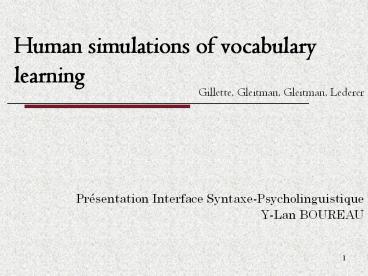Human simulations of vocabulary learning PowerPoint PPT Presentation
1 / 21
Title: Human simulations of vocabulary learning
1
Human simulations of vocabulary learning
Gillette, Gleitman, Gleitman, Lederer
- Présentation Interface Syntaxe-Psycholinguistique
- Y-Lan BOUREAU
2
Outline
- Some background
- The problem to be solved
- Facts nouns acquisition precedes verbs
acquisition - Existing theory
- Gillette et al.s hypothesis
- Simulation experiment
- Learning from observation
- Learning from linguistic hints
- Discussion
3
The problem of language learning
- Children learn language from scratch
- Traditional hypothesis
- Children hear adults speak
- They spot that cat is uttered most frequently
when there is a cat around - They infer that cat means cat
- But babies vocabulary does not reflect input
frequencies - much more nouns than verbs in babies vocabulary
4
Nouns are learnt earlier
- A conceptual hypothesis
- Verbs are conceptually more difficult
- So cannot be learnt until babies display adequate
conceptual knowledge - Alternative hypothesis information requirements
- Verbs require some syntax to be already acquired
(e.g. I know that Mommy is coming)
5
Pairing word to world
- Three sources of information
- Nonlinguistic evidence (e.g. Mommy says cat
when the cat is there) - Linguistic evidence
- Co-occurrence of semantically related words in
sentences (e.g. food names usually appear with
verbs like eat ) - Syntactic structures in which words occur (e.g. a
verb with one subject and two complements is
likely to be of the give kind)
6
Hypothesis
- Hypothesis the baby
- (1) acquires a small stock of nouns by
word-to-world pairing - (2) uses that stock of nouns as a scaffold for
constructing representations of the linguistic
input that will support a more efficient learning
procedure - Support correlation of changes in vocabulary
size with appearance of multiword speech
7
A simulation experiment
- Principle
- Adult learners
- (no conceptual issues any more)
- Trying to guess most frequently used nouns or
verbs - Observational clues video clips
- Linguistic clues co-occurring words, syntactic
frame
8
First experiment
- Only videoclips
- Adults trying to guess 24 nouns and 24 verbs
9
Results, Part I Nouns win
- Nouns are guessed with much better results than
verbs
10
Imageability rules
- Provided clues are exclusively visual
- Nouns of the set (e.g. elephant, plane, bag) are
a lot more imageable than verbs (e.g. think,
know, wait)
11
Results, part II
Nouns
Nouns
Verbs
Verbs
12
Conclusion of experiment I
- The one relevant factor seems to be imageability
- Not that surprising from a video, you learn
imageable things a thing that is not imageable
would be hard to picture !!
13
Linguistic clues vs. Observational clues
- All nouns removed.
- 6 conditions
- 1 videoclips (but with a bip for the verb)
- 2 alphabetical lists of nouns
- 3 12 (videoclips alphabetical lists)
- 4 syntactic frames with all nonsense words
- 5 sentences with only the verb as nonsense
- 6 15 (videoclips sentences)
14
Linguistic clues vs. Observational clues
15
Linguistic clues vs. Observational clues
- 6 conditions
- 1 videoclips (but with a bip for the verb)
- 2 alphabetical lists of nouns
- 3 12 (videoclips alphabetical lists)
- 4 syntactic frames with all nonsense words
- 5 sentences with only the verb as nonsense
- 6 15 (videoclips sentences)
16
Results
Nouns reintroduced
No nouns provided !! No more visual information !!
Visuals reintroduced
17
Linguistic clues vs. Observational clues
- Remarkably leap between 3 and 4, whereas the
reverse could have been expected ! - Interestingly, those verbs that were best learnt
in the observational learnings show a decrease
between 3 and 4
18
Discussion
- Verbs complementary distributions (12 never
learnt with visual clues 12 best learnt with
linguistic clues) - This distribution corresponds to the
imageability criterion - Quite logically, you can learn visually only what
is visually representable - Verbs that use higher level linguistic
representations have to wait until those can be
constructed
19
Discussion general scheme
- First, imageable words are learnt on a
word-to-world pairing basis - Those imageable words are mostly nouns
- That would explain why nouns make up most of
young infants vocabulary - Second, this first set of words allows learning
of new words on a sentence-to-world pairing - Thus conceptual words can be learnt as well
20
Some reservations
- The argument structure is the same across
languages (logical requirements), but - Adults already know the words, so they could try
to guess the verbs by exhaustive search with all
the information given (e.g. the best
performance is for look , and it is probably
due to the use of look with at )
21
The End

